In a quest to “slow down” a little (relatively speaking), a while ago I rode the 2021 BMW R nineT (along with a few others I’d checked out in the line), and after describing riding it to friends, I thought I’d put down this 2021 BMW R nineT review.
I eventually decided to save around 40% of the purchase price, forego cruise control, and buy a 2017 BMW R nineT. I’ll talk about that a bit later.
A lot about the 2021 BMW R nineT tickles me as an everyday bike. It’s a really good mixture of a low-tech bike setup, character-rich engine, and high-tech rider aids to keep me alive.
But I was curious about what it’d be like for me, coming off Japanese sport bikes and Italian naked bikes. I was curious
- Does the ageing boxer twin really have enough “character” to make up for it being pretty low-tech?
- How does the BMW R nineT handle?
- Is the R nineT a good commuter — can you split lanes, and can you park it easily in weird situations?
- Is the R nineT decent on the highway, or am I going to get blown off the top once I clear 100 km/h (60 mph)?
Here’s what I found out.
For the 2024 model year, BMW is introducing the R 12 and R 12 nineT, apparently closing out the variants of the R nineT — for now. See more about those models here.
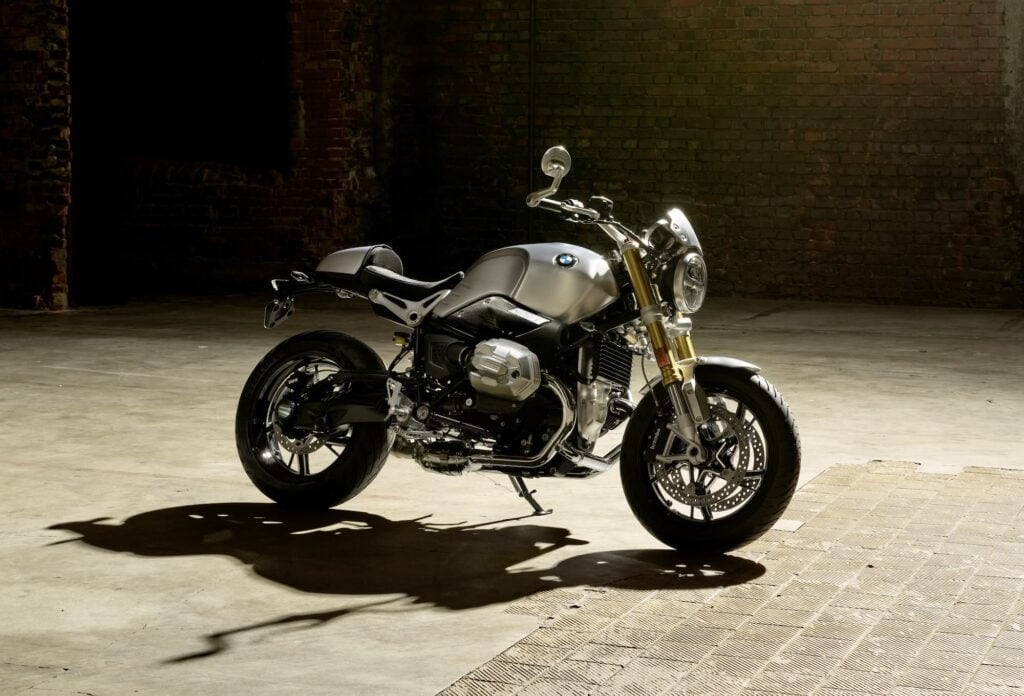
Are you obsessed with motorcycles?
Well, I am. That’s why I created this site — as an outlet. I love learning and sharing what others might find useful. If you like what you read here, and you’re a fraction as obsessed as I am, you might like to know when I’ve published more. (Check the latest for an idea of what you’ll see.)
The 2021 R nineT in a nutshell
In a nutshell, the R nineT line of bikes is a BMW naked/minimalist roadster where you pay quite a lot for the privilege of minimalism (if you buy new).
There are many better, cheaper bikes, but “better” is riddled with subjectivity. For all-around utility at any kind of speed (from slow to blazing fast), the similarly-priced BMW S 1000 R is better, for example — more comfortable, higher-tech, faster, and remember, similarly priced.
But the R nineT gets people like you and me to pay for the privilege of an air/oil-cooled engine from the early 2010s, a shaft drive, and to think that a tachometer and adjustable USD forks are premium features, and that you don’t need a gear shift indicator — because most of the R nineT range doesn’t come with those things standard.
What every R nineT bike (since 2014 — see our generational guide to the R nineT) has in common is the engine and drivetrain. They all share an 1170cc twin cam motor (the “Camhead” or “twin cam” in the generational series of BMW boxer engines), a dual overhead cam air/oil-cooled opposed “boxer” twin with big cylinder heads sticking out the side of the bike.
Since the first 2014 R nineT, the engine has always made 81 kW (110hp) of peak power around 7500-8000 rpm — just where a lot of people with sporty intentions like to live on the street. The engine redlines shortly afterwards, but it’s not a bike I enjoy bouncing off the limiter.
All the R nineT bikes also share a shaft drive and forks (either upside down or conventional), rather than a Telelever front suspension common to other R bikes of the era like the R 1200 R.
Of the R nineT line, the BMW R nineT (with no other words after it) is the premium bike of the line. I kind of wish they called the best one the “Ultimate” or the “Pro” or something. The others all get a word, like Scrambler or Urban G/S etc.
Instead, because the highest-spec R nineT has no more words after it, I have to just say “I have an R nineT,” and then pause for long enough that the person realises I’ve ended my sentence. But even then, they’ll usually have to clarify. “Pure? Scrambler?” etc.
The top-of-the-line BMW R nineT end of sentence! No more words! comes with fully adjustable front USD forks and dual gauges, including a — wait for it — tachometer and a gear position sensor (things I didn’t realise were “features” until retro bikes). The rear suspension is also adjustable.
The bikes also share rider aids in each generation, which from 2021 onward include cruise control and a standard Bosch IMU, which means cornering ABS and lean angle-aware traction control. Basically, all these bikes will try to correct your silly mistakes, like jamming on the brake in a corner filled will gravel.
The Pure, Scrambler, and Urban G/S don’t have the advanced suspension and tachometer (though the short-lived Racer did have a tachometer). Their forks are non-adjustable and they come with only one gauge. On top of that, the Scrambler and Urban G/S have a shallower rake on the front forks, giving them slightly lazier handling.
This puts the R nine T in rare territory — an old-school engine, low-maintenance drivetrain, and cruise control. Apart from a few examples from Harley-Davidson and Moto Guzzi, I can’t think of any others that can offer that.
What makes the 2021 BMW R nineT Special?
Those looking at the steep sticker price of a new BMW motorcycle — and especially comparing the new 2021 BMW R nineT’s price to other amazing BMWs in the line up — might think “Wait, why would I pay this much for a bike that’s deliberately old-school?”
There are four things I really like about the R nineT:
- It has an air/oil-cooled, but still high-performance engine
- It has a shaft drive
- The motorcycle is lightweight and easy to ride
- And the 2021 BMW R nineT in particular has lots of electronic convenience.
The BMW R nineT’s air/oil-cooled engine
Before going into the fact that it’s one of the last air/oil-cooled engines on new standard motorcycles, let’s get one thing out of the way — the torque and response curve of the BMW R nineT’s engine is awesome and very suited to a roadster style bike.
Response of the BMW R nineT engine
The engine responds a bit like an excitable mid-capacity cruiser engine. This is what the torque curve of the BMW R nineT looks like:
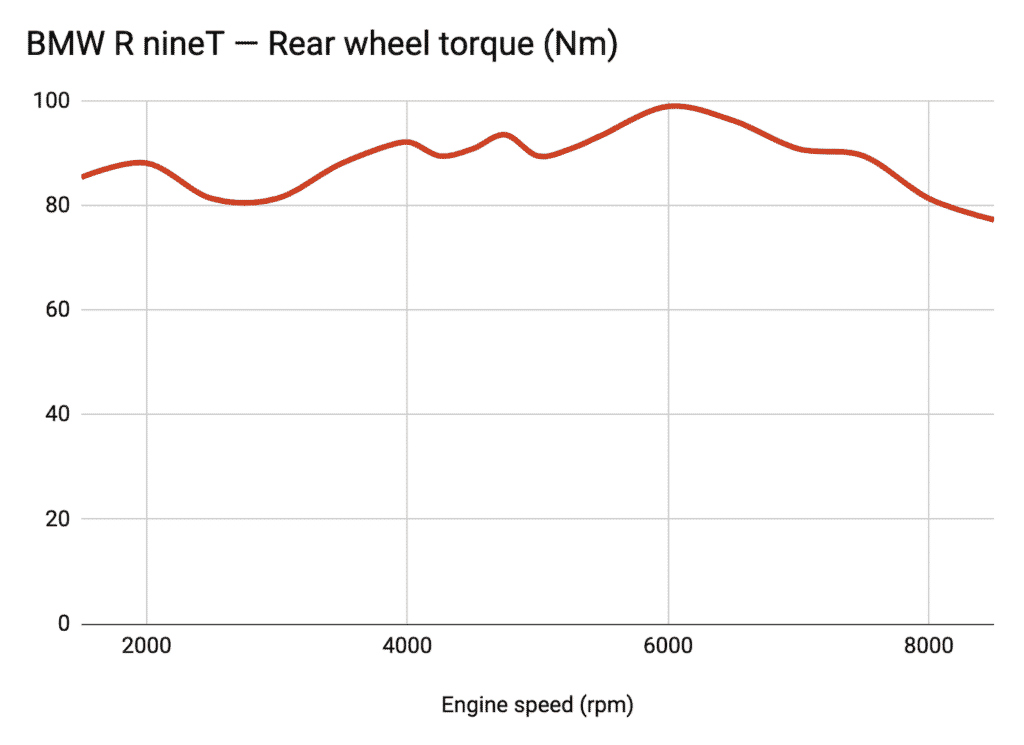
The torque peaks at around 95 Nm (70 ft-lb) at the wheel at 6500 rpm, but that doesn’t tell you about how it’s making over 80% of this as low as 1500 rpm. It’s not at all a bike you have to rev up or worry about short-shifting, and it’s not a bike worth revving out to its peak RPM. I like to shift around 7500 even when I’m being aggressive.
You can see from the above composite torque curve (from multiple dyno runs) that there’s basically torque everywhere. The downside to the torque curve, by the way, is that it’s quite “lumpy” as they go. But maybe this is character…
So anyway, that’s why people love the BMW boxer engine in roadsters.
One thing that is pretty unique about boxers is the way the whole motorcycle kicks over to the right when you grab the throttle at idle. This is a consequence of spinning up a crankshaft that runs lengthwise to the motorcycle.
You’ll get the same kick on K-bikes (like my old BMW K 1200 RS), with their longitudinally mounted engines, or Moto Guzzis, with their longitudinally mounted V-twins. The axle on each these bikes runs lengthwise.
It’s a weird feeling, at first. When I first experienced the lateral kick of a transverse boxer engine revving up, I was shocked. Doesn’t this make it harder to corner while accelerating? I thought? (No, I’m told: The rotation of the shaft drive counters that.)
In the end, you can describe the side-ways kick of a boxer twin as: a) character, b) engineering, or c) a weird flaw. I choose a). Mostly because I’m paying for it… But the way the R nineT kicks over to the side does seem cool. Alive, almost.
(Actually, the arguments for longitudinally-mounted engines in motorcycles are quite interesting. I’ll analyse that separately.)
Why the air-cooled boxer (and not liquid-cooled)?
If you follow BMW motorcycle engines, you might know that the engine in the BMW R nineT was a “premium” engine in other BMWs only up to 2013-2015.
The BMW R 1200 GS got a partially liquid-cooled engine from the 2013 model year, and the GSA got it from 2014 (both announced late the previous years). The last holdout was the R 1200 R, which got it from late 2014.
So from 2015 onward, the whole BMW range, including the new BMW R 1200 RS, all had the liquid-cooled engine. But not the BMW R nineT.
“Boo, hiss,” wail those who decry liquid cooling. “Keep things old school.” I get it! I like old-school. But there are good reasons for liquid cooling, and there are more upsides than you might think.
Liquid cooling came in part because of emissions restrictions. Many motorcycle aficionados feel that emissions restrictions are anathema to their passion and are making all that was once pure become suffocated by catalytic converters and red tape.
The emissions restrictions aren’t just about what comes out the tailpipe, by the way. There are also restrictions on noise from the engine. That’s not always a good noise, either.
But let’s keep a balanced view. There are two distinct benefits of liquid cooling:
- Lower maintenance costs. Keeping an engine cool means that the valves are less likely to need adjustment. The valve maintenance intervals on liquid-cooled engines is always (as far as I’ve seen) wider — often double — that of air/oil-cooled engines.
- Power. You can run higher compression ratios, rev higher, and generally get more power out of the same capacity engines when they’re liquid-cooled, and still benefit from the lower maintenance costs.
See more of my take on comparing liquid cooling and air/oil cooling on motorcycle engines here.
The disadvantages of liquid cooling are, of course, also obvious:
- Additional weight of the cooling system (though offset by less metal required to sink the heat from the engine in an air-cooled engine)
- You have to replace the coolant once every four years (or sell it)
- You have to worry about the cooling system’s integrity — leaks, water pump failures, corrosion, etc.
- Potential additional ugliness in front of the motorcycle — though BMW, Triumph, and Indian (and many others) do it quite well
Both air-cooled and liquid-cooled bikes can overheat on a hot day when not moving. It’s not clear-cut to say one is better than the other — it varies by motorcycle.
So on balance, air/oil-cooling is an aesthetic, design, or lifestyle choice. It’s a simple pleasure for me knowing that I never have to worry about coolant temperature, leaks, or changing the coolant, wondering if I should use the expensive BMW stuff or figuring out what the value pick is.
And I pay that price with more often having to adjust the valves, and taking only 81 kW (110 hp). That’s quite a bit of power. I’ll take it!
Caveat: Some people on forums do experience overheating shutdowns. If you live in a really consistently hot place and drive a lot in traffic (sounds tough!) then maybe you would benefit from a liquid-cooled bike.
The R nineT’s Shaft Drive
Shaft drives have pros and cons.
In a nutshell, a shaft drive means more weight, more expense in manufacturing (passed on to the consumer), and less configurability, but it also means less maintenance — no chain to clean or lube, no chain/sprocket set to replace.
For tourers, roadsters, and basically any bike that’s not destined for the track, the shaft is a more logical choice. So it’s disappointing (to some people anyway) to see so many premium touring motorcycles use a chain and sprockets.
The BMW R nineT’s weight, riding position, and general rideability
Another thing I like is the R nineT’s riding position, its weight, and its general rideability.
The riding position of any bike in the R nineT range (other than the discontinued Racer) is what I’d call “standard”. It varies somewhat with the Urban G/S and the Scrambler, but it’s still in the standard range — somewhere between adventure touring and sport bike.
The riding position, coupled with the fact that its weight isn’t excessive (~220 kg or 500 lb wet) and held down low, makes the BMW R nineT VERY easy to ride.
On your first ride, even as a relatively inexperienced or non-aggressive rider rider, the position is confidence-inspiring. It’s easy to decide “Hey, I’m going to give it full beans!” and wring the throttle (briefly).
On long rides (3+ hours, which I do very rarely), your legs might get cramped if they’re long. But not as badly as if you were on a sport bike. Anyway, I shake them out, or have to fuel up and take a brief break, and it’s all good.
The 2021 BMW R nineT’s electronic rider aids
Finally, the rider aids of the 2021 BMW R nineT are worth mentioning.
I do like bikes that lack everything. I have had many bikes whose only claim to technological fame was fuel injection. And many others, too, like my Ducati Monster 900 that etched its way indelibly into my heart.
But for my everyday bike, I’ve learned that ABS saves me sometimes when I make dumb mistakes. For example, I grabbed a bit too much brake once in a parking lot and slipped and would have hit a car (just gently, but annoyingly for all involved), if not for ABS.
The 2021 BMW R nineT motorcycles (and those that come after it, of course) have the next level — cornering ABS, with a six-axis IMU to measure every direction in which the motorcycle might be accelerating.
Its Bosch computer uses those inputs to adjust ABS and even engine power to make sure that the tyres maintain maximum contact with the surface. You don’t stand up while braking, and you don’t slide out while accelerating. It’s magic, and it makes you feel like you’re invincible.
On top of that, the 2021 BMW R nineT motorcycles have cruise control.
If you’ve ever suffered from a tingling right hand like I do, you should try electronic cruise control. Nothing is like it. Throttle locks give relief, but cruise control lets you totally relax. (Throttle locks leave me a bit stressed as I have to be on guard as to when to release it when braking.)
There are many motorcycles with cruise control, quite a few of them cheaper than the latest R nineT, but on the 2021 BMW R nineT you can get cruise control as an ex-works option — and in some markets, it’s standard.
Riding the 2021 BMW R nineT
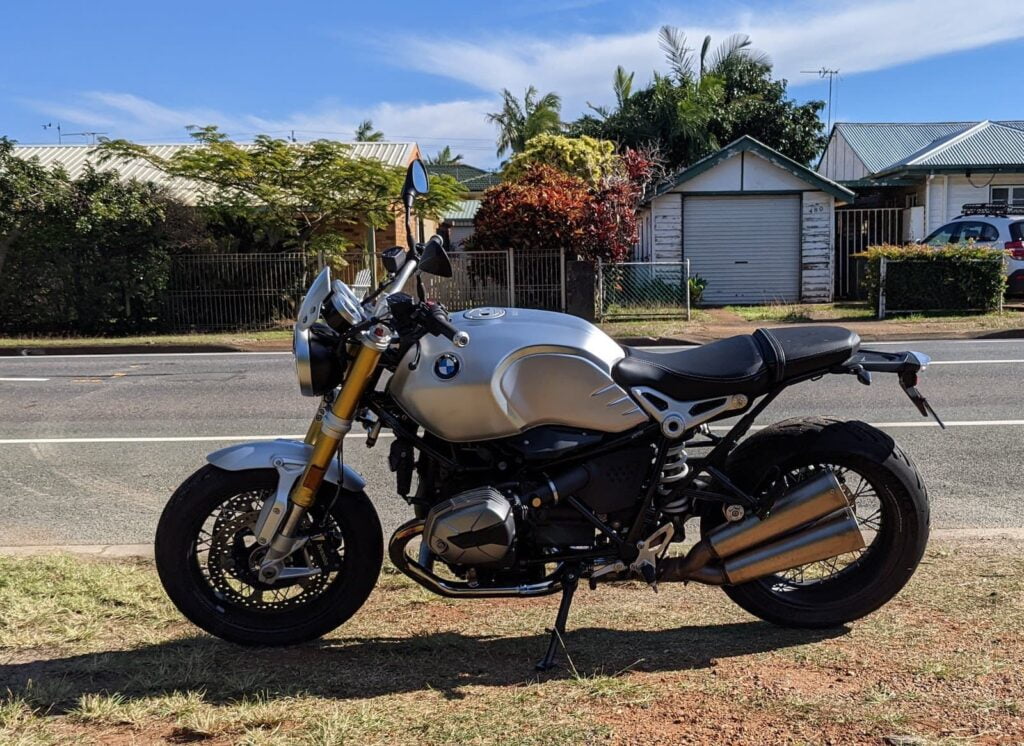
I’ve always liked the BMW R nineT in concept. I know quite a few people who’ve compared them favourably to the Triumph 1200 line (the R nineT is faster), or to the Ducati Monster 1100 (the R nineT is a lot faster).
I like the 2021 BMW R nineT for all the reasons above that make it special. But I also wanted to mention what it’s like to ride.
General riding and character on the 2021 BMW R nineT
For context, after I rode the 2021 BMW R nineT, I bought a 2017 BMW R nineT which has the same motor. I’ve also ridden Hexhead and Twincam BMW R 1200 GS models.
As brief background, I mostly have ridden sport bikes, sport tourers, adventure tourers, nakeds, and standards. OK, that’s a lot of kinds of bikes. Also a few tourers on test rides (none of them really tickled me).
I’ve found that when road riding, I generally like to have a bike that I can blast around on and not feel like it’s lethargic or being over-revved. I don’t mind shifting, but I don’t like having to shift into third gear just to get to freeway speeds, so most bikes under 35 kW (50 hp) don’t really do it for me.
Conversely, while I really like getting near a redline, I don’t do it often in everyday riding on sport bikes. I never hit the redline on my Hayabusa (sacrilege!) and I only did on my 600cc sportbikes at the track (where I’d try to shift before it).
In everyday riding, I like “torque everywhere”. That’s what the R nineT delivers. From anywhere above 1500 rpm, I can crack the throttle in most gears and it squats down and goes. I can hold the throttle down to any point and just shift when I want to.
There have been a few times when I wished the R nineT revved just a little more. But then again, didn’t I get this bike to slow down a little…
Braking on the R nineT is also ample for everyday riding. Being able to accelerate quickly is scary unless you have the brakes to pull it up; the R nineT is well-equipped in that domain. I’ve ridden standards with single-disc front brakes and won’t go back to them.
By the way, even though I was apprehensive about the single disc on Harley-Davidson Sportster S, it was fine in practise for that style of bike.
Traffic riding with the BMW R nineT
The one part of riding the BMW R nineT I didn’t / don’t really enjoy was riding in traffic. I noticed this on my brief test ride and I confirmed it with long-term ownership of the older model.
Basically, it’s just because the R nineT is slightly too wide for splitting narrow lanes (which is part and parcel of riding in every part of the world other than most states of the US).
If lane splitting were legal in more of the US, lane splitting on the R nineT wouldn’t be a problem there… lanes are wider there, from my experience and a lot of watching rides on YouTube! Cruisers can split lanes with relative ease in the US, other than in tight city traffic, so it’d be easy enough on the BMW R nineT.
But in congested areas in Australia and Europe I really prefer a narrower roadster or even a sportbike.
Part of the problem with lane splitting on the BMW R nineT is the handlebar. And I may swap mine out for a narrower bar.
But the other part is the cylinder heads. I’ve scraped them on a couple of things (not cars, luckily) at low speed, and having them sticking out to the sides does concern me a bit.
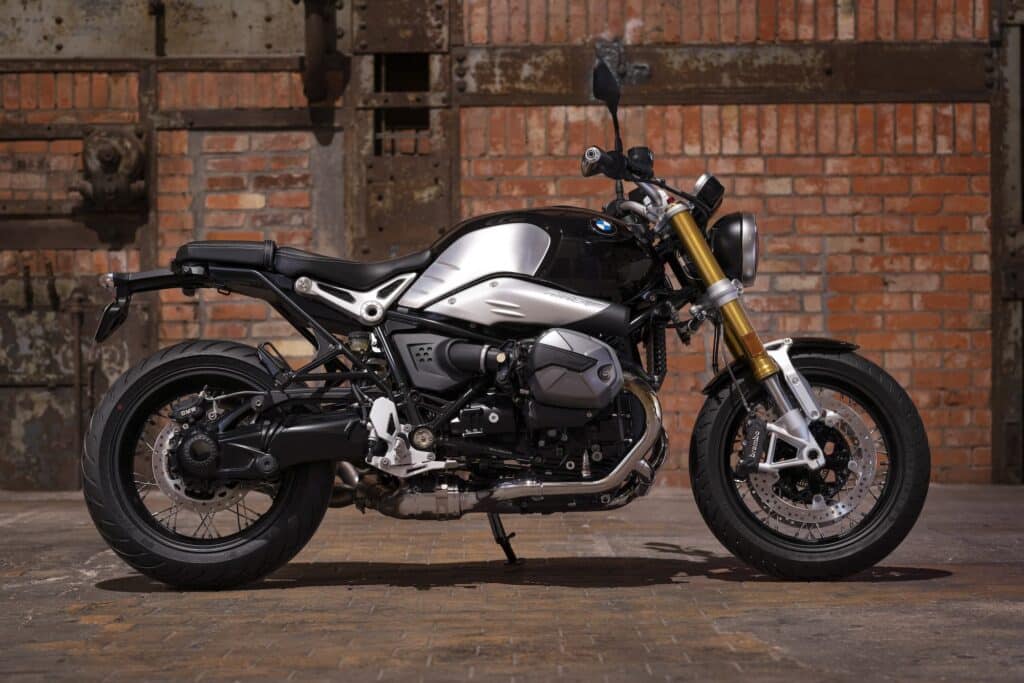
Sport riding
There are some things that are sporty about the BMW R nineT, like the suspension, the relatively low weight, and the brakes. I know people even take them to the track — particularly the Racer. But I wouldn’t call the R nineT a sport bike.
The only time I’ve ever felt like the R nineT ran out of puff was when I tried to ride it like a sport bike and rev it past 100 km/h (60 mph) in first gear. It doesn’t do that, so don’t expect it to!
As a caveat, you can ride the R nineT sportily. I’m sure in good hands you’ll be able to flog people on “proper” sport bikes with ease. And next to a lazier big-bore cruiser, the riding position of the R nineT will feel quite extreme — I mean, you are leaning forward slightly, and the footpegs are quite high.
I just didn’t find too aggressive riding was the natural happy place of the R nineT.
Freeway riding on the 2021 BMW R nineT
The R nineT isn’t really a good freeway bike, and the cruise control on the 2021 BMW R nineT doesn’t make it much better.
I found that above 100 km/h I’d get pretty tired after about 30 minutes from the wind pressure.
Wrist pressure is fine. I didn’t even use the cruise control on the 2021 R nineT for extended periods as I was riding with other cars around so did have to adjust my speed.
But it’s a naked bike. It’d benefit from a windshield to deflect some of that pressure. Unfortunately, small windshields (like the Dart flyscreen, or other stylish offers from Rizoma) don’t really do much other than protect the instruments — on other bikes, I’ve found zero impact on chest pressure and other R nineT riders say the same about these little screens.
You COULD fit a bigger screen to the BMW R nineT. Some generic ones fit. But they distinctly change the aesthetics of the bike. (One thing I do sometimes is test windscreen heights and shapes using cardboard.)
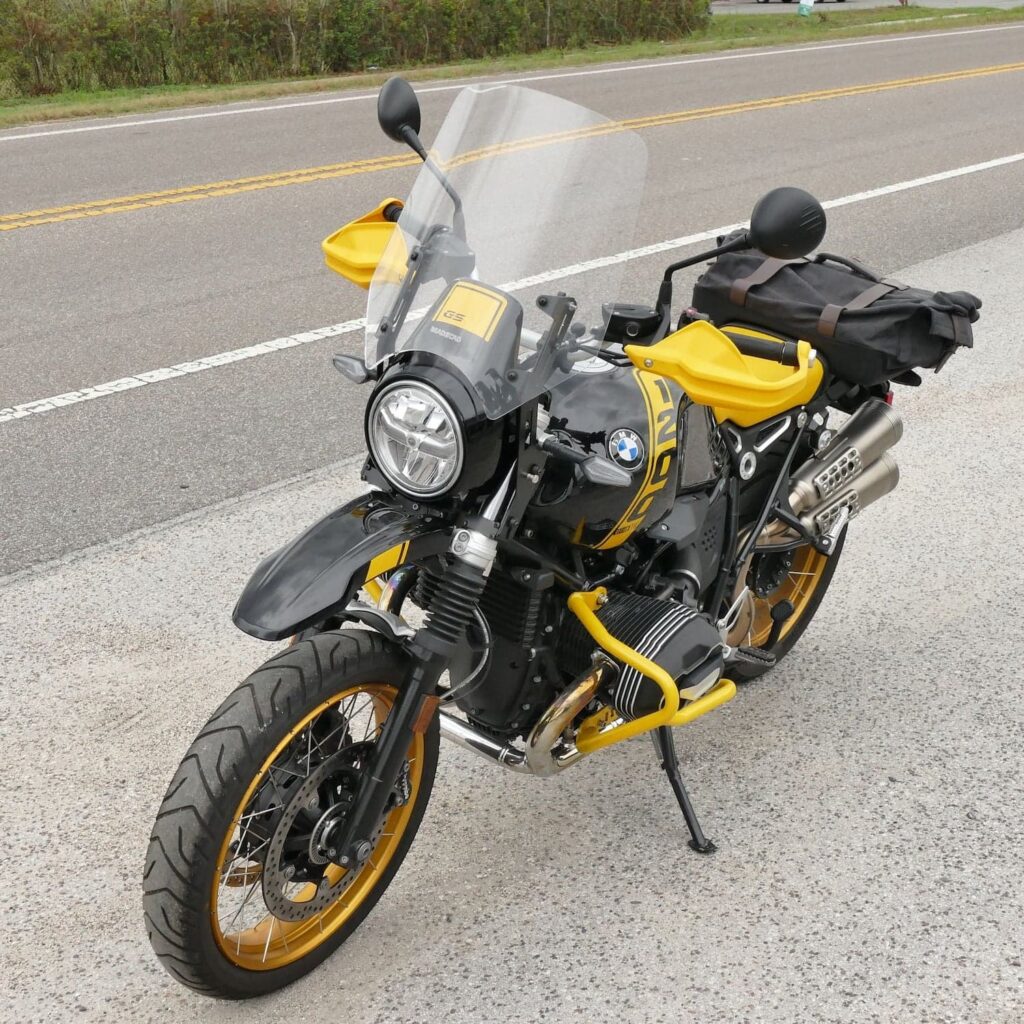
Maintaining the 2021 BMW R nineT, and R nineT reliability
It’s good to go into motorcycle ownership with eyes open. You might wonder about general problems with a motorcycle like the R nineT or how reliable it is… but the short answer is that very little goes wrong unless you don’t maintain it.
All the components in the R nineT are old and proven. This extends from
- The Boxer engine — in its twin-cam configuration it has existed since 2010, and the 1170 cc block has been in use since 2004
- The shaft drive — BMW has been using them for a very long time (decades)
- The electronics — BMW has had well-functioning ABS systems for over a decade. And there is relatively little tech on the BMW to go wrong — no ESA, for example.
Poring over the Servicing and Maintenance section of the R nineT forums, most questions are about routine things. I don’t see many threads saying it won’t start or whatever. At worst, it seems sometimes they need a new battery.
So the question is — what maintenance do you have to do?
Servicing the 2021 BMW R nineT boils down to
- Service every 10000 km / 6000 miles including oil/filter change (which you do annually if you don’t cover the distance) and checking the valve clearance. You can check the spark plugs too (it’s easier to turn the engine), and have some on standby, even though the replacement interval for spark plugs is wider.
- Change the transmission oil every 40,000 km (24,000 miles). This is an easy, DIY job.
- Change the coolant every… just kidding 😉
As it’s a big, shaky twin, it’s good practice to tighten down bolts periodically. For that, it’s useful to know key torque specs. These are in the manual.
One thing that’s core to servicing your 2021 BMW R nineT is the GS-911 diagnostic tool and the GS911 adaptor cable.
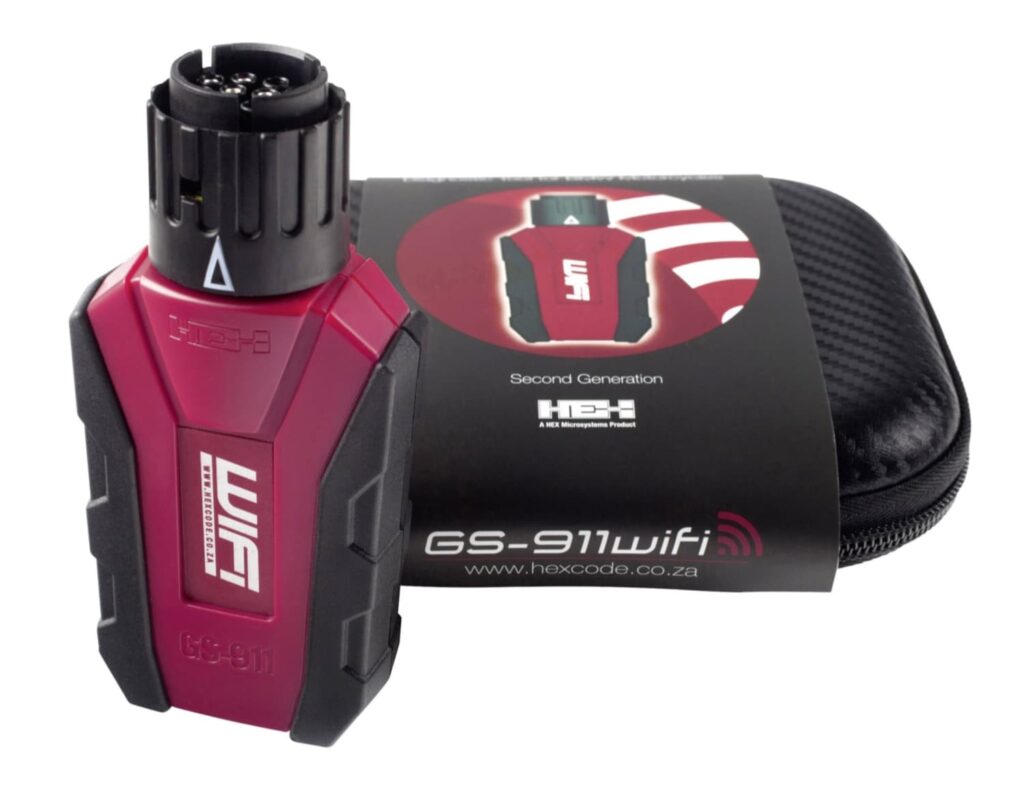
The GS-911 tool lets you connect your computer or phone with the BMW’s computer. The very minimum you can do is reset the service codes. Most people use it to read diagnostic codes. But it has really rich diagnostic features that go far beyond that — should the occasion arise.
One thing that does tend to plague some R nineT owners is oil consumption or leaks. Some report leaks from the rear main seal, the cylinder heads, and other places.
I had an oil leak on my R nineT — and it was expensive. Roughly a month after buying it, I had to replace the rear main seal. This meant splitting the bike in half. The seal itself was cheap ($50 or something), but 8 hours of labour cost me a lot, and it was too much work for me to do at home with the space I had available at that time.
Some owners also report oil consumption that is down to poorly seated valves, or in some cases, an out-of-spec cylinder.
It does all worry me a bit and wonder if I should go back to purely Japanese motorcycles… but then, there’s no such thing as a 100% trouble-free bike. We do it for love! (Or we’d all just take the metro or e-bikes or whatever other transport is most convenient.)
Competitors to the BMW R nineT
The BMW R nineT doesn’t have any exact competitors. It’s pretty magical in that way!
The two most direct competitors I can think of are the Triumph 1200cc range and the Moto Guzzi 1200 range.
In the Triumph range, there’s the Scrambler, the T120, the Thruxton, and the Speed Twin. They all perform their functions in unique ways.
Unlike BMW’s variants in the R nineT line-up, Triumph tunes the engines differently for each purpose.
Let’s pick the Triumph Thruxton 1200 RS, for example, the sportiest of the line-up.
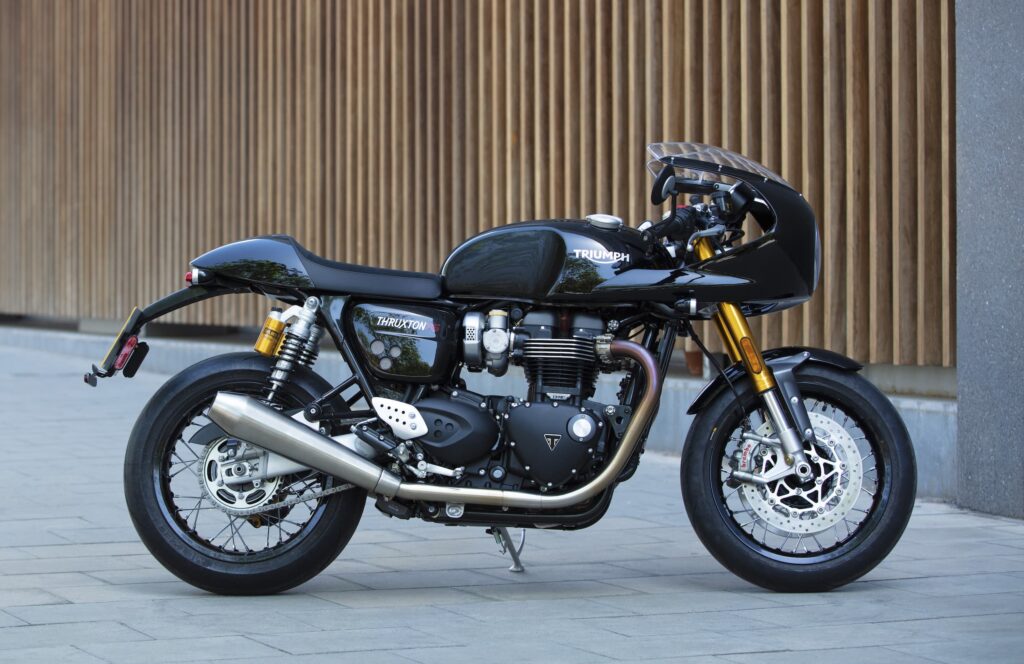
The Triumph Thruxton RS is quite a high-spec bike for one that has “retro” pretensions. In that sense, it has some parallels with the R nineT.
But the Thruxton RS has some actual sportbike spec bits. It has Öhlins front and rear suspension that’s fully adjustable, Brembo M50 callipers (the same that we saw on top-end superbikes just a few years ago), and ride modes.
See here for our FAQ on motorcycle braking systems, including a quick overview of types of Brembo calipers.
So it might be a better “sport” bike. Is it a better bike? No. It’s different. Forget the engine configuration (opposed twins and parallel twins aren’t really better than each other in any objective way), the Thruxton is liquid cooled and has a chain drive, rather than air/oil-cooling and a shaft drive.
Despite having liquid cooling, by the way, the Thruxton is a similarly low-revving bike to the R nineT. Neither of them is a screaming four.
And finally, the Thruxton RS doesn’t have cruise control or an IMU.
OK. On to the Moto Guzzi Griso.
The Griso has evolved over the years. First from an 1100 to a 1200, and then the 1200 evolved from 2 to 4 valves per cylinder, and then finally in 2013 or so Moto Guzzi rectified a problem with the valves of earlier 8V engines.
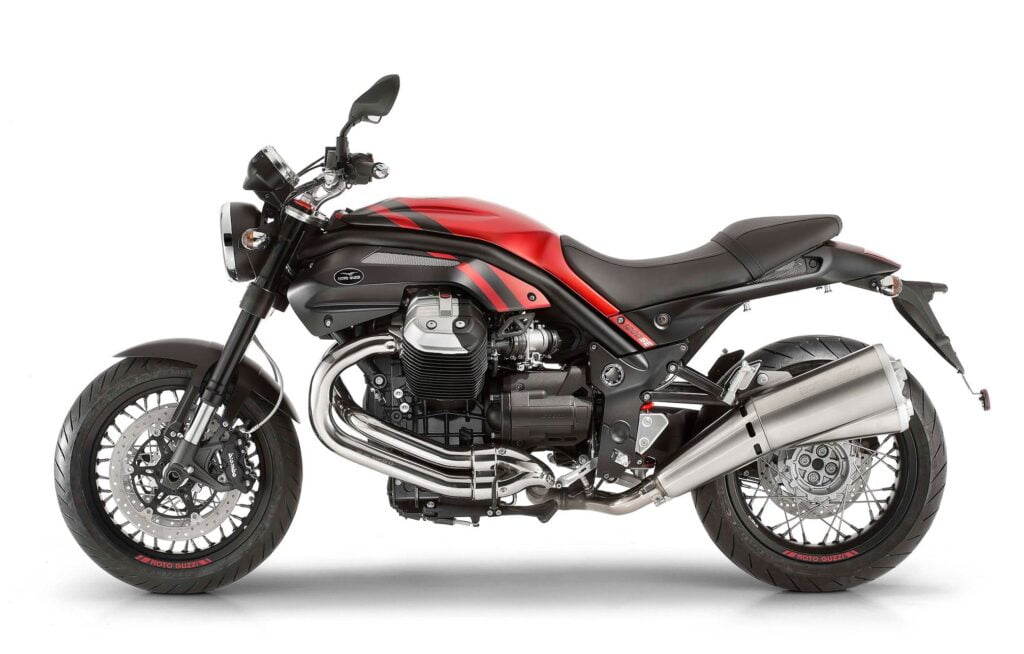
A later-model Moto Guzzi Griso 1200 8V would be an excellent alternative to the BMW R nineT. It is basically a similar bike but with a V-twin rather than a boxer twin.
Aside from that, it’s an air/oil-cooled standard sport bike with a shaft drive, a single-sided swinging arm, Brembo brakes, and fully adjustable suspension. Plus, it looks great!
The engine even makes a similar amount of power, with a claimed 81 kW / 108 bhp @ 7500 rpm, and 108 Nm / 80 ft-lb @ 6400 rpm.
Unlike the 2021+ BMW R nineT, the older Griso doesn’t have cruise control or an IMU. Earlier models don’t even have ABS.
The Moto Guzzi Griso 1200 8V is no longer sold new, sadly, so it isn’t really competition. If you find one used… have a look at it, as it’s unique and will remain so. You might have to pay a bit more to keep it on the road, but then you’ll have a community of enthusiastic Guzzi nuts to help you with bits. They’re also going up in price.
Opinion — Should you get the 2021+ BMW R nineT?
If you’re considering getting the 2021 BMW R nineT, you’re considering thinking: Should I get the newer model for the six-axis IMU (and cornering ABS and TC) and cruise control… or should I spend around 30% less money?
In my unsolicited opinion, I think the earlier (2017-2020) BMW R nineT is the better buy. Here’s why.
Firstly, cruise control is cool but not critical on a roadster. There are very few situations where you need it. Cruise control is great on big adventure sport bikes, cruisers, and tourers, where you might actually want to maintain a steady speed for periods of more than a few minutes.
But on the R nineT… I don’t want to spend many hours on the bike at the same speed. I ride shorter distances — maybe 2-3 hour rides at most, with breaks in between to stop off in cool places, and with a lot of throttle variation in between.
Cruise control just isn’t really necessary on this bike. If you want a brief respite from holding the throttle, a throttle lock or palm wrest do the same thing… I know this because I used them on a 24-hour long ride (spread over five days).
In some ways, cruise control is more necessary on the BMW S 1000 RR superbike, which has such a forward-leaning position that your wrists will be screaming after a while!
Secondly, you might consider the safety options of the cornering ABS and traction control functions.
These are great — I’ve maintained a list of motorcycles with them here. But ABS and TC on the previous BMW R nineT already give you a lot of value. Yes, your bike might stand up a little when going around a corner if you grab on the brakes — but most of the value is there in standard ABS. So that seems enough.
The only caveat to getting an older BMW R nineT is that very few are sold. These are bikes people hold on to!
Wrap-up
I really like my BMW R nineT. I do think of moving on (as I do from nearly every bike), but there’s so much about it that’s unique.
Very few bikes these days are made with an air/oil-cooled engine, analogue gauges, and ABS. The Moto Guzzi V7 is one exception — cool bike, but a lot less powerful.
Tack on the fact that the BMW R nineT has sweet handling and is good-looking from every angle and it’s just hard to pass up on.
The only reason I’d sell it is to have other experiences. But they wouldn’t necessarily be better ones.

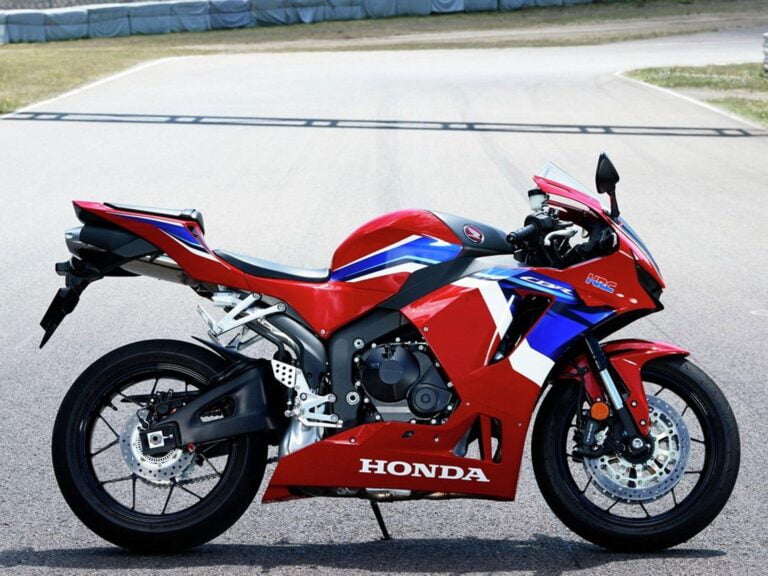
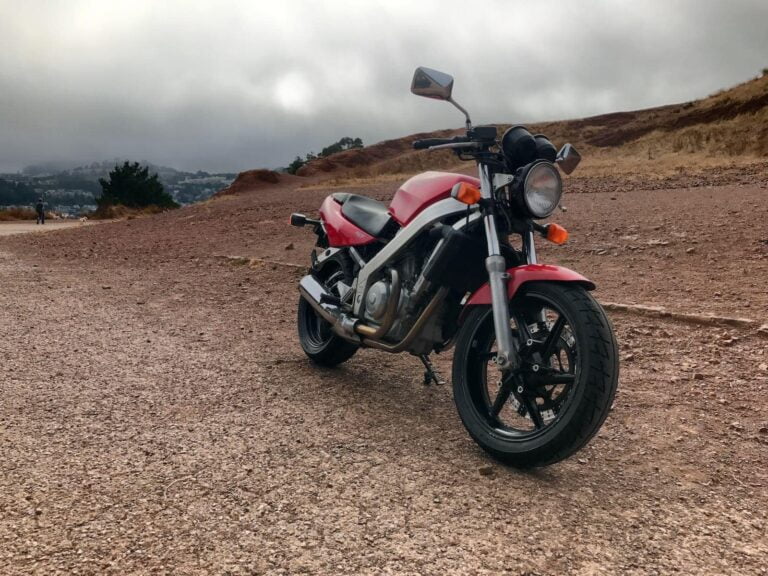
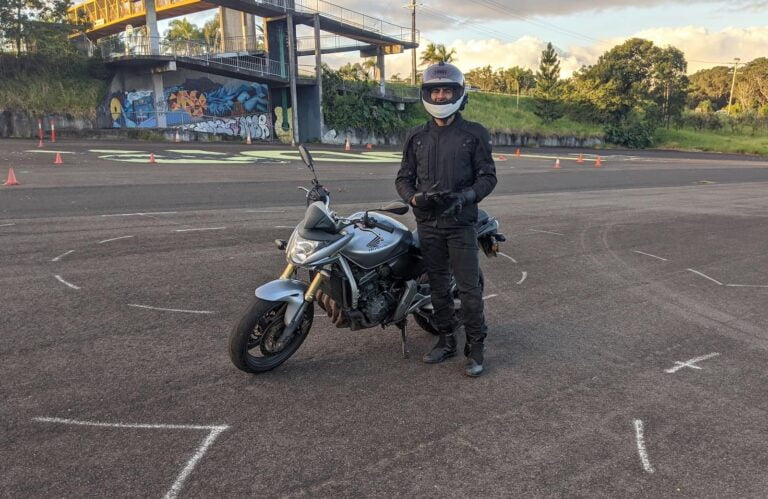
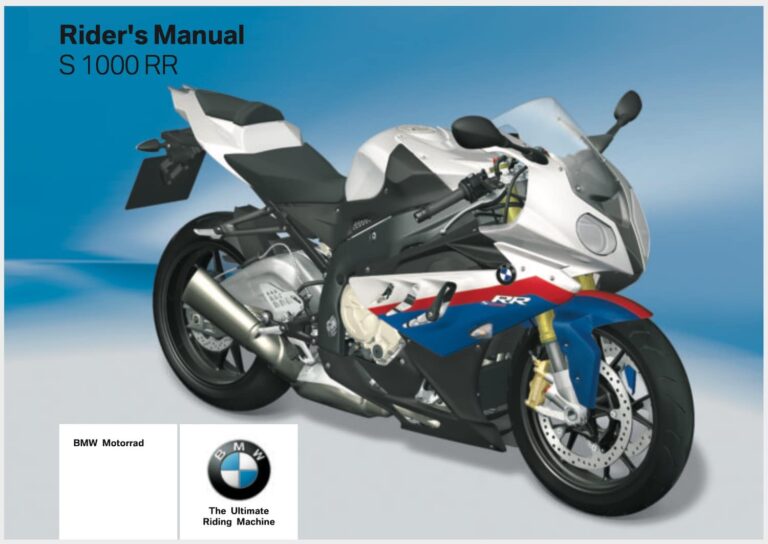
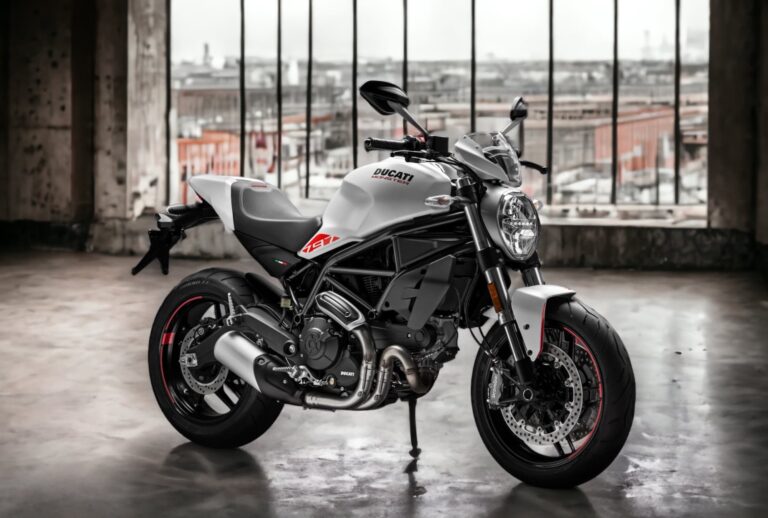
![Triumph Electric Motorcycle TE-1 Prototype — Final Results [Updated] 14 Triumph Electric Motorcycle TE-1 Prototype — Final Results [Updated]](https://motofomo.com/wp-content/uploads/2022/02/Triumph-TE-1-Electric-Motorcycle-Prototype-rhs-side-view-768x512.jpg)
The 2013 GS was first to get the liquid cooled boxer. The GSA got it in 2014.
I’m thinking of buying a BMW R nine T so the article was very helpful. Thank you.
Test rode one. When I shopped, I jumped on 2016 r9t. Overcooked a corner, leaned forward and turned the bike. Did a u-turn, wrote a check.
Amen, Brother.
This is a fantastic article. I went from. Triumph speed twin to a 2014 R nine T, to a 2015 GS and now back in a 2021 R Ninet urban GS (40th year anniversary) that was an impromptu buy whilst getting a service on the older GS. I do the extras compared with the 2014 model including the led lighting and I’d hate to admit it but, yes, the cruise control. This was a no brainer for my 50 something old wrists. I don’t like Maintaining chains and lived the boxer aesthetics. It’s such a subjective thing. It’s a bike I’ll keep and add another (or two) in time.
Thanks for putting the time is writing this. Extremely well written and informative.
This is by far the best RnineT review on the web hands down. Well done sir. Intelligently written, balanced and very informative. Ultimately this has helped me make up my mind that I will buy the 2021 model because of the extra safety features. Thanks Dana. Excellent moto-journalism. I’ll check out your other work.
Brilliant review…loads in there to think about. I nearly got the r nine t but went for more practicality, less power (and less money) with the guzzi V85tt.
Great pick, I’m actually kind of surprised how cheap the V85 TT is given it’s a good-looking Italian bike. Though my used four-year-old R nineT was cheaper than a new V85 TT (and there are very few used ones), otherwise I may have been tempted too!
Very well written. I moved from the 2017 r NineT Pure to 2021 scrambler. I do use cruise control pretty often however it’s not that crucial. 2021 also has much better light when you ride in the dark. It’s also much quieter than euro 4 model and it lost it’s wonderful pops and cracks when decelerating. I’m still very happy with new model though!
So, I have a 2012 R1200R. Brilliant machine. Comfortable. Has luggage, good handling, and the same motor. 60 k miles no issues. Saw a very low mileage 2015 r9t. What to do?
You would have to try it. You might very well like your anti-diving telelever more than the fork on the first gen R nineT.
It’s practicality v aesthetics.
The R1200R is practical and huge fun. Heated grips esp.
The R9T is stunning and huge fun.
I’ll be passing the bike shop on the way to a rally tomorrow.
You have painted a very compelling picture and got me thinking hard.
I’ll let you know!
Tried it.
Loved it.
The riding stance was perfect for me at 5″9
Suspension and handling excellent.
The R9T is a cracking bike.
And better for no electronics.
But the R1200R wins for me on practicality.
I can’t say anything negative really bar on this one not having heated grips.
Again your review is spot on.
Hi Dana,
Good report thanks.
One point, all Grisos have 6-speed transmission.
Regards
Andrew
I am a fair weather rider in the UK , and have a 2009 R1200R . Absolutely love it . No electronics but it does have heated grips . A new bike would be nice but I can’t justify the huge cost to get one. Current bike has 22k miles only
I briefly owned an R9T Option 719 (??), which was always a head-tyrner and attracted many comments. But I hated it – riding position for my 5’9″/10″ was very uncomfortable although I added ‘bar risers and a footpeg lowering kit.
I loved the premium paintwork and overall styling except for the twin pipes, which I swapped for a single tasty BOS job. Engine braking was phenomenal, acceleration great, but overall I just couldn’t live with it – and I was/ am a rusted-on BMWer from 1997, with an initial R1100R, then R1150R, and several later R1200Rs and GS’s being owned and loved.
And to politely contradict your claim that there are ‘very few’ used R9Ts for sale, here in Oz at least there are always very many available, far more than the modest initial new sales of the bike should suggest. But- great and objective writing – thank you.
Thanks. Outstanding information on great bike, which I rode 400 km on Nov 4th and 5th 2022 here in sunny tropical Thailand. I am 73 double TKR survivor. This was one of my best test rides – ever. Like hooligan 180 km/h on the straights near the Myanmar border 05:30 in morning. What an amazing machine! The BMW Motorrad R nine T Pure.
Myanmar? Wow, I keep hearing about hooligan riding in the most unexpected places. Very inspiring. Glad you like it!
Dana,
Your article inspired me to explore this beautiful roadster.
I don’t have anything against any Manufacturer.
After being a Harley rider for 20 years (96, 103, 110, 114), upgrades (Stage 1, Stage 2) – I really wanted to go back to my younger years with the Yamaha RD350 and the XS100. So out of frustration, earlier this year, I traded in for a K1600GTL. Powerful bike, but too much bike. I felt that I went from bad to worse (Anybody find the chariot disturbing??). Rode that 2022 R9T three days ago – belonged to a friend and felt like I was 18 again. Found a barely used model ridden 98 miles somewhere in Odessa, FL. Rode the 1600 in hurricane weather to Odessa, picked up the R9T and just kept riding on i75N and i75S for 200 miles before I came home. This thing changed my life. My wife didn’t understand why my iPhone was navigating towards home and then several miles north and back again in storm weather. I even took in-roads when the raindrops started hurting my face and it was liberating. Guys on this forum will probably understand what I feel. I will come back in Six months to confirm that my search for the perfect bike is over.
Excellent review. Well done.
I have been lucky enough to own a version of most sports bikes (original Blades, ZX7’s, every incarnation of R1 and 916’s through to Panigale’s etc) over the past 30 plus years and have been regularly riding on road and track since the late 70’s (now 60 years of age). About 6 years ago, I began my move to naked bikes with a MT10 whilst still retaining a big bang R1 and a K1600GT in the garage for touring with the wife. I was stupidly persuaded (say badgered) to sell the R1 to a friend and soon found that I was missing my occasional sports bike kick.
Having seen the R9T and took a real liking to it’s design, I decided to buy the Racer. No test rides, just an impulse buy. I kid you not, within 2 miles of my initial ride, I was besotted. I love to feel character in a bike and this thing had more character than any other bike I had ridden. Some might say they are quirks or even the results of a basic and poorly engineered design, but whatever they are, I love them. What I didn’t love was the Racers riding position. I could cope with 50 to 80 miles, but long days out with pals on their comfortable nakeds were leaving me with back, neck and wrist pain. The R1 felt like a tourer at the side of this thing!
Fast forward to April 2022 when I purchased a new R9T in 719 aluminium and with virtually every BMW extra. All the benefits and character of a Racer but with the typically comfortable riding position of a naked. I’m 6ft 1″ and never suffer any aches regardless of time/distance covered. This bike has the additional Dynamic mode incorporated and pick up from the throttle is notably better and more immediate than the Racer. Equally, the fuelling is simply magnificent and very predictable, the best of any bike I have ridden. Handling is equally impressive when pushing on up to 9/10th’s (and I do tend the ride the bike hard). Loads of feedback from the front, not bad from the rear, but the shock does show up some limitation’s. I’ll be upgrading this and will start with a new, stronger spring from K-tech (did this on the MT10 and worked a treat). Ground clearance is good provided you bin the hero blobs which grind out way too early. I can assure you it’s capable of some proper knee down action if that’s your thing. Where it’s limitation show up (the 10/10th’s area) are on fast transitional changes of direction, quick turning left to right and right to left manoeuvres. If you try forcing the bike too quickly in these situations it will protest and shake it’s head. Far better to let the bike flow and be as smooth as possible.
Both my R9T’s have used oil. This appears to be common but generally levels out after 10 to 12k miles. After saying this, all my BMW’s have used oil (and the running in process is always adhered to), R9t’s, RT’s, K1600’s and even a number of BMW petrol cars that I’ve owned. Maybe it’s a BMW thing, but keep an eye on the level and top it up regularly to be safe.
This all sounds like I’m a major BMW fan, yet nothing could be further from the truth. I don’t think they are the most reliable bikes out there and am a firm believer that when the Japanese get it right, they really get it right. But, we either tend to buy bikes with the heart or from the perspective for the level of practicality they offer (tourers for example). The R9T is one from the heart. It shimmies, it shakes, it pops and bangs and no two rides ever feel the same. You can enjoy it as much at 60mph as you can flat out and it never gets boring. A one hour test ride will unlikely be enough to convince anyone, but give it time to get under your skin as it has mine and you’ll forever be looking for an excuse to grab the keys and your helmet. Enough said.